March 6, 2018

By Chris Hurt
Will Rogers said: “Never blame a legislative body for not doing anything. When they do nothing, they don’t hurt anybody. When they do something is when they become dangerous.”
Well, Congress and the president did something early this year, and it is likely to help hog producers. I am talking about the Tax Cuts and Jobs Act that changed federal income tax law.
The advantages for the pork industry come in two forms. One is the impact tax reform will have on consumption of pork; the second is potential benefits directly to hog producers in the form of potentially lower federal tax payments.
Pork consumption
The new law nearly doubles the standard deduction and lowers the tax rate for most brackets. The net result is that many households, but not all, will pay less in federal taxes. For those getting a regular paycheck, this means many will have fewer dollars withheld for federal income tax. Less withholding means an increase in the size of the paycheck. That means more income for those households.
It turns out that when people have more income, they tend to spend some of the additional income on meat. Domestic consumers with added income will increase beef consumption more than pork consumption, but there is at least some positive benefit for the pork industry.
The reduction in federal taxes is expected to help the U.S. economy grow at a little bit higher rate. Higher U.S. income growth will have some spillover toward a bit faster income growth in the world economy, and that should help us sell additional pork to our foreign customers, as well.
Your tax bill
The new tax law also has the potential to lower the amount of federal income taxes that hog producers must pay in 2019. The higher standard deduction and lowered tax rates will help many.
In addition, the provision that allows expensing of capital purchases means pork producers, and other businesses, can write off as an expense the purchase price of buildings and equipment in the year of purchase.
Also, potentially lowering the taxes paid to the IRS is the provision in the new law that exempts the first 20% of income from “pass-through” income, like from the Schedule F for farm income. Pork producers will want to check with their tax adviser for specific provisions and limitations in the new law and how they affect their situation.
So far in 2018, hog prices have been higher than during the same period last year. The outlook continues to favor prices staying near or slightly higher than 2017 prices, when the annual carcass price was almost $66 per carcass hundredweight.
Pork supplies will be about 3% higher this year, so strong demand continues to be the reason prices are holding up. We can now add the new tax law as an additional factor helping to support pork demand this year.
Hurt is a Purdue University Extension agricultural economist. He writes from West Lafayette, Ind.
You May Also Like




